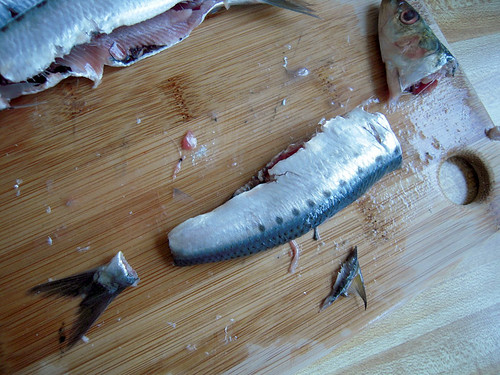
I love sardines - canned or fresh. My addiction started as a child when my mother would serve sardines from a can with a dab of kewpie mayonnaise. Packed with protein and fun to eat, they are also better for big blue because they are low on the food chain.
When you can get your hands on some fresh sardines - take the challenge. Make sure that the eyes of the fish are not cloudy and the skin looks shiny and sparkly. My local Japanese fish market always has some wild sardines in stock. It's best to go in the morning and eat it that day. Don't freeze these suckers because when it comes time for defrosting, the guts will be all oozy and the eyes bloody. Yeah. Gross.
Generally, fish mongers will not clean the sardines for you because it would really take up too much of their time. I would just feel bad, even if they did offer because I usually buy at least 6 at a time.
The process may seem daunting but once you clean two, it almost becomes meditative. And learning to scale and clean a small fish is a great un-intimidating way of getting your hands into the world of cleaning fish.
Scaling a Fish
One of the things that makes me gag (besides
cooking octopus) is when I am eating fish and I can feel a
gill scale floating around in my mouth. This is a total turn off for me - it has happened more than a few times in Japan.
Scaling is an easy task - just take the back of your knife and in a downward motion (from tail to head) shave off the
gills scales. I use a small paring knife for a sardine because it gives me control on such a small fish.
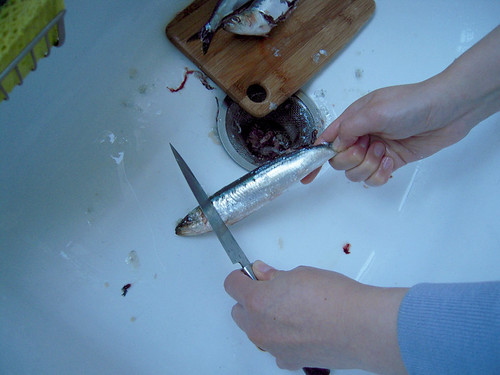
The
gills scales can fly in curious places, so make sure you are doing this in a sink instead of next to your new $3K Jura-Capresso 13423 Impressa S9 One Touch Automatic Coffee-and-Espresso Center, Platinum machine. (I don't have one, I'm just putting an example out there.)
Cleaning the Fish
Get ready for an intimate relationship with your fresh friends.
Locate the anus.
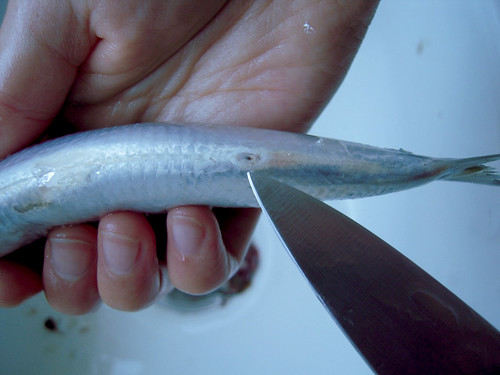
Make an incision with the sharp side up with your knife from the anus all the way to the head. The reason why you open up the fish sharp side up is that if you do it the other way, you might puncture all the innards and it would just be more of a mess than necessary.
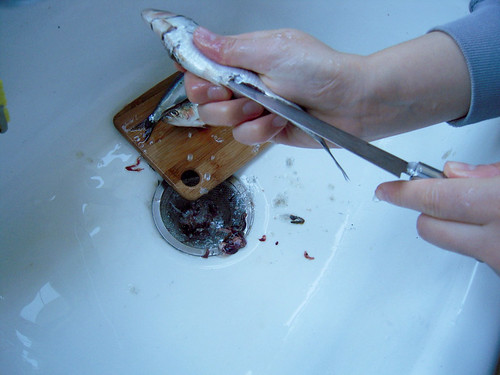
Okay, now that you have opened up the sardine from anus to throat you will see the wonderful anatomy of the sardine - bladder to esophagus. Take all the innards out with your fingers. Run it under some cold water to wash away any residue.
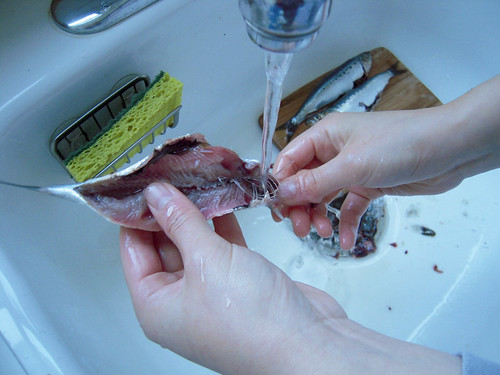
That's it.
I usually keep a cutting board nearby where I can proudly accumulate my clean fish.
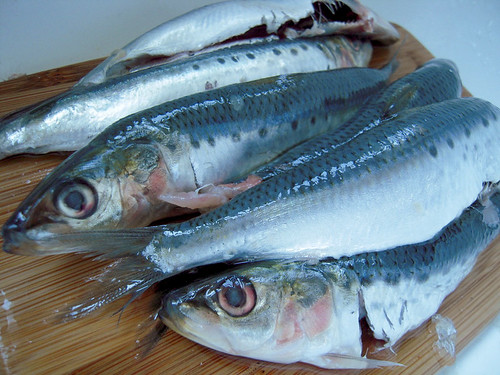
Here's a video to drive the point home. (Thanks http://incompetech.com/ for the royalty free music. The title of the song is "Four Beers Polka")
http://www.youtube.com/watch?v=mLajQvcOaKI
And now for a to-die-for nikomi (simmered) sardine dish.
 Sardines simmered with Ginger and Umeboshi
Sardines simmered with Ginger and Umeboshi
6 sardines
2 umeboshi
1-2 inches ginger
Simmering liquid
1/2 cup water
2 tbsp sugar
1 tbsp mirin
1/4 cup sake
1/4 soy sauce or tamari
1. Clean sardines.
2. Cut off the head and tail and divide the sardine in half (do not filet).

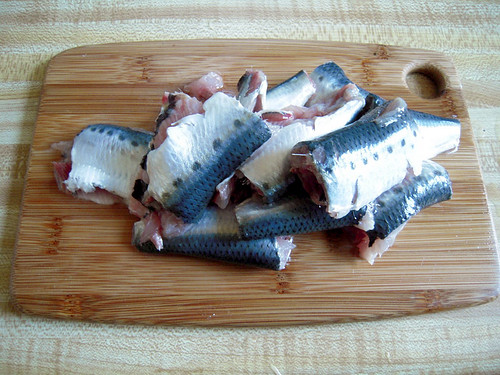
3. Slice the ginger into thick coins - skin on.
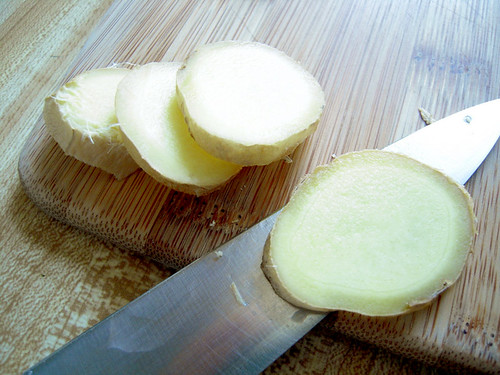
4. Puncture the umeboshi with a toothpick in several places.

5. Put all the ingredients for the simmering liquid into the pan over medium heat.
6. Once it starts to simmer, place the fish, umeboshi and ginger in the pan. Make sure not to overlap the fish. Use the lid, but don't cover it complete - leave room for a little bit of steam to escape.

7. Simmer over low heat for 10-15 minutes. The simmering liquid should reduce to about 1/2 of its original amount.
Over a fresh bed of rice, this dish was addictive. The salty soy sauce, sweet mirin and sour umeboshi served as an amazing base for the sardines which turn out fluffy. The zing of the ginger is an essential touch as well.
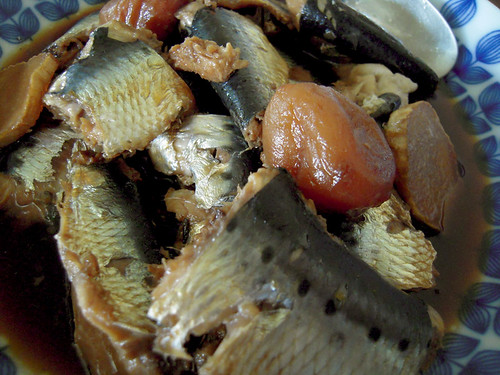
 I love sardines - canned or fresh. My addiction started as a child when my mother would serve sardines from a can with a dab of kewpie mayonnaise. Packed with protein and fun to eat, they are also better for big blue because they are low on the food chain.
When you can get your hands on some fresh sardines - take the challenge. Make sure that the eyes of the fish are not cloudy and the skin looks shiny and sparkly. My local Japanese fish market always has some wild sardines in stock. It's best to go in the morning and eat it that day. Don't freeze these suckers because when it comes time for defrosting, the guts will be all oozy and the eyes bloody. Yeah. Gross.
Generally, fish mongers will not clean the sardines for you because it would really take up too much of their time. I would just feel bad, even if they did offer because I usually buy at least 6 at a time.
The process may seem daunting but once you clean two, it almost becomes meditative. And learning to scale and clean a small fish is a great un-intimidating way of getting your hands into the world of cleaning fish.
Scaling a Fish
One of the things that makes me gag (besides cooking octopus) is when I am eating fish and I can feel a
I love sardines - canned or fresh. My addiction started as a child when my mother would serve sardines from a can with a dab of kewpie mayonnaise. Packed with protein and fun to eat, they are also better for big blue because they are low on the food chain.
When you can get your hands on some fresh sardines - take the challenge. Make sure that the eyes of the fish are not cloudy and the skin looks shiny and sparkly. My local Japanese fish market always has some wild sardines in stock. It's best to go in the morning and eat it that day. Don't freeze these suckers because when it comes time for defrosting, the guts will be all oozy and the eyes bloody. Yeah. Gross.
Generally, fish mongers will not clean the sardines for you because it would really take up too much of their time. I would just feel bad, even if they did offer because I usually buy at least 6 at a time.
The process may seem daunting but once you clean two, it almost becomes meditative. And learning to scale and clean a small fish is a great un-intimidating way of getting your hands into the world of cleaning fish.
Scaling a Fish
One of the things that makes me gag (besides cooking octopus) is when I am eating fish and I can feel a  The
The  Make an incision with the sharp side up with your knife from the anus all the way to the head. The reason why you open up the fish sharp side up is that if you do it the other way, you might puncture all the innards and it would just be more of a mess than necessary.
Make an incision with the sharp side up with your knife from the anus all the way to the head. The reason why you open up the fish sharp side up is that if you do it the other way, you might puncture all the innards and it would just be more of a mess than necessary.
 Okay, now that you have opened up the sardine from anus to throat you will see the wonderful anatomy of the sardine - bladder to esophagus. Take all the innards out with your fingers. Run it under some cold water to wash away any residue.
Okay, now that you have opened up the sardine from anus to throat you will see the wonderful anatomy of the sardine - bladder to esophagus. Take all the innards out with your fingers. Run it under some cold water to wash away any residue.
 That's it.
I usually keep a cutting board nearby where I can proudly accumulate my clean fish.
That's it.
I usually keep a cutting board nearby where I can proudly accumulate my clean fish.
 Here's a video to drive the point home. (Thanks http://incompetech.com/ for the royalty free music. The title of the song is "Four Beers Polka")
http://www.youtube.com/watch?v=mLajQvcOaKI
And now for a to-die-for nikomi (simmered) sardine dish.
Here's a video to drive the point home. (Thanks http://incompetech.com/ for the royalty free music. The title of the song is "Four Beers Polka")
http://www.youtube.com/watch?v=mLajQvcOaKI
And now for a to-die-for nikomi (simmered) sardine dish.
 Sardines simmered with Ginger and Umeboshi
6 sardines
2 umeboshi
1-2 inches ginger
Simmering liquid
1/2 cup water
2 tbsp sugar
1 tbsp mirin
1/4 cup sake
1/4 soy sauce or tamari
1. Clean sardines.
2. Cut off the head and tail and divide the sardine in half (do not filet).
Sardines simmered with Ginger and Umeboshi
6 sardines
2 umeboshi
1-2 inches ginger
Simmering liquid
1/2 cup water
2 tbsp sugar
1 tbsp mirin
1/4 cup sake
1/4 soy sauce or tamari
1. Clean sardines.
2. Cut off the head and tail and divide the sardine in half (do not filet).

 3. Slice the ginger into thick coins - skin on.
3. Slice the ginger into thick coins - skin on.
 4. Puncture the umeboshi with a toothpick in several places.
4. Puncture the umeboshi with a toothpick in several places.
 5. Put all the ingredients for the simmering liquid into the pan over medium heat.
6. Once it starts to simmer, place the fish, umeboshi and ginger in the pan. Make sure not to overlap the fish. Use the lid, but don't cover it complete - leave room for a little bit of steam to escape.
5. Put all the ingredients for the simmering liquid into the pan over medium heat.
6. Once it starts to simmer, place the fish, umeboshi and ginger in the pan. Make sure not to overlap the fish. Use the lid, but don't cover it complete - leave room for a little bit of steam to escape.
 7. Simmer over low heat for 10-15 minutes. The simmering liquid should reduce to about 1/2 of its original amount.
Over a fresh bed of rice, this dish was addictive. The salty soy sauce, sweet mirin and sour umeboshi served as an amazing base for the sardines which turn out fluffy. The zing of the ginger is an essential touch as well.
7. Simmer over low heat for 10-15 minutes. The simmering liquid should reduce to about 1/2 of its original amount.
Over a fresh bed of rice, this dish was addictive. The salty soy sauce, sweet mirin and sour umeboshi served as an amazing base for the sardines which turn out fluffy. The zing of the ginger is an essential touch as well.





Comments (7)
I just gagged. I HATE sardines! I am a shameful Japanese, who can’t eat any small fish due to their tiny bones.. I am so horrified by the look of the above pics. Great instruction, but I hope the day I put a knife in someone’s anus is far far away.
I’ve never heard scales called gills before. As far as I know, the gills are the organ behind the head used for extracting oxygen/depositing CO2 in water.
Oops Craig you are right! Not GILLS. Thanks for your keen eye. Editing the video now…
So interesting to hear about small fish from other cultures! My Grandfather worked in a Sardine canning factory in Norway as a child and I grew up we ate Sardines straight from the can or on white bread sandwiches with butter. Only after moving to the West Coast did I even realize that Sardines could be fresh!
Now I love them all ways, though not all of my friends agree.
I can’t wait to try this preparation.
Whoa Yoko, EPIC POST!
I was lucky enough to eat this dish with the JAPANIFY household and it was absolutely delicious. I did not even let the ginger go to waste.
And that video is totally priceless. Nice lacy shirt! Where did you get that?? Captured 1980s Japanese cooking show television perfectly.
Yama- It always boggles me that despite your fickle palette, you still manage to cook so well. Although you do eat natto, so that must be it.
Yamahomo – Yeah, I agree, knifing an anus is weird, even if it’s into a little sardine.
Erik – That is so interesting about your Grandpa – do you have photos of that. Is the factory still open. I have gotten recommendations for sardine sandwiches since moving back to the states. I will try it soon.
Kayoko – Yeah, so great that you ate the ginger too! There was nothing left of this dish. RE: my shirt is gray – not lacy. Hahaha, I think it’s the low res that makes it look like lace.
Umeboshi in the nikomi sounds yum. I’ve never gutted fish, but I’m up for a challenge.